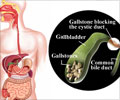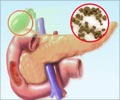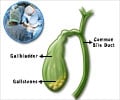- U.S. National Library of Medicine- Medline Plus-Acute Cholecystitis - (https://medlineplus.gov/ency/article/000264.htm)
- Radiology Info for Patients- Cholecystitis - (https://www.radiologyinfo.org/en/info.cfm?pg=cholecystitis)
- Harvard Health Publishing- Cholecystitis - (https://www.health.harvard.edu/digestive-health/cholecystitis)
- Australia & New Zealand Gastric and Oesophageal Surgery Association (Cholecystitis) - (https://www.healthdirect.gov.au/cholecystitis-gallbladder-inflammation)
What is Cholecystitis?
Cholecystitis is an inflammation of the gallbladder, a small pear-shaped, sac-like organ located in the upper right side of the abdomen, just below the liver. The liver produces a substance called bile to help in the digestion of fats in our food. The bile is stored in the gallbladder and released into the duodenum (first part of the small intestine) during the digestion process. The bile travels out of the gallbladder through the cystic duct, a small tube that leads to the common bile duct and from there into the small intestine.
Cholecystitis usually develops when a gallstone gets stuck at the opening of the gallbladder. If a gallstone blocks the cystic duct, the bile becomes trapped in the gallbladder and can then lead to inflammation of the gallbladder.
Twenty five percent of people who have acute cholecystitis usually develop another episode within the first year and sixty percent have another episode within the next five to six years.
What are the Different Types of Cholecystitis?
There are two types of Cholecystitis:
- Acute Cholecystitis: This is a sudden inflammation of the gallbladder and usually causes severe abdominal pain, often with nausea, vomiting, and fever. Pain is mostly localized between the shoulder blades. This condition requires immediate attention as it can be a life-threatening situation.
- Chronic Cholecystitis: When acute Cholecystitis persists for several months or years, it is known as Chronic Cholecystitis. Chronic Cholecystitis may not have any symptoms at all or may cause intermittent abdominal discomfort. This condition causes damage to the walls of the gallbladder causing it to become thickened and scarred. As a result the gallbladder may shrink in size and lose its ability to store and release bile properly.
What are the Causes of Cholecystitis?
- Gallstones: In about ninety five percent of all cases of Cholecystitis, the gallbladder contains gallstones which are solid accumulations of cholesterol, bile pigments, and calcium. When these gall stones block the opening of the gallbladder, bile accumulates within the gallbladder. Even though the gallbladder continues to contract, the bile cannot pass out of the gallbladder normally. Chemical changes from the stagnating bile trapped within the gallbladder and occasionally bacterial infection result in damage to the gallbladder wall.
- Biliary sludge or Gallbladder sludge: This is a thick concentrated liquid which builds up in the gall bladder and is also called a pseudolith, or "fake stone". This can happen during pregnancy and also if you have lost lots of weight quickly.
- Tumors: The presence of tumors in your pancreas or liver may stop the bile from draining out of the gallbladder properly, resulting in an accumulation of bile which can lead to Cholecystitis.
- Injury: If there is any injury to the abdomen due to severe burns, sepsis, trauma, or surgery it may result in inflammation of the gallbladder.
- Prolonged fasting: This may cause gallbladder sludge to build up, resulting in Cholecystitis.
- Vasculitis: Inflammation of the blood vessel walls which supply the gall bladder may cause thickening and weakening of the blood vessel walls resulting in damage to the gallbladder. Systemic infection, infections of the gallbladder, diabetes and infestation with worms are also some uncommon causes for developing Cholecystitis.

What are the Symptoms and Signs of Cholecystitis?
- Pain in the upper right-hand side of the abdomen. The pain is intense and starts suddenly. Taking a deep breath will make the pain feel more intense. The pain may radiate from the abdomen to the right shoulder or back.
- Bloating of the abdomen
- Loss of appetite
- Nausea and vomiting
- Fever and chills
- Jaundice
- Light colored loose stools

What are the Complications of Cholecystitis?
- Perforation in the wall of the gallbladder
- Peritonitis or inflammation of the lining of the abdomen
- Gangrene or tissue death
- Pancreatitis
- Empyema or pus in the gallbladder
- Surgical complications include injury to the bile ducts draining the liver
- Fistulas or formation of abnormal connections between the gallbladder and other organs such as the duodenum, large intestine or stomach
- Emphysema of the gallbladder, in which certain bacteria that produce gas infect the gallbladder
How do You Diagnose Cholecystitis?
The doctor will review your medical history and ask about any such previous episodes of abdominal discomfort, especially those which are triggered by high fat meals. The doctor will also enquire if there is any recent rapid weight loss. During the physical examination, your doctor will observe and palpate the upper right portion of your abdomen, to feel your liver and gallbladder.
Complete Blood Count (CBC): A high white blood cell count may indicate an infection.
Liver Tests: High levels of bilirubin, alkaline phosphatase, and serum aminotransferase may also help the doctor make a diagnosis.
Pancreatic Enzymes: There may be elevations of enzymes such as amylase and lipase if there is inflammation of the pancreas.
Abdominal Ultrasound: This procedure is painless and uses sound waves to produce pictures of the gallbladder and the bile ducts. This test is usually the first test which is performed to confirm the diagnosis of gallstones and Cholecystitis.
Cholescintigraphy (HIDA Scan): In this procedure you are given an injection of a radioactive chemical that passes out of the blood into the bile ducts. This scan creates pictures of the liver, gallbladder, biliary tract and small intestine.
Abdominal CT scan: This test may be performed to get detailed pictures of the gallbladder along with the liver, bile ducts, intestines and pancreas.
ERCP: This test uses a long, flexible tube which has a light and camera at the end. This tube is passed down your throat into the stomach and into your small intestine. This test uses a dye to check the flow of bile.
Magnetic Resonance Cholangiopancreatography (MRCP): This is an MRI exam that produces detailed images of the liver, gallbladder, pancreas, pancreatic duct and bile ducts. It is the most powerful of the imaging tests to identify gallstones, gallbladder, bile duct inflammation or blockage of the biliary system.
Hepato Biliary Nuclear Imaging: This is a type of nuclear medicine imaging that uses a radioactive tracer to help evaluate disorders that affect the liver, gallbladder and ducts.

How do you Treat Cholecystitis?
Initial treatment of acute Cholecystitis includes correction of electrolyte abnormalities and pain killers. Non surgical methods include low fat diet, eliminating fat intake and fasting to rest the gallbladder.
You may be prescribed medication such as Camylofin for relieving abdominal pain and other medicines to control symptoms of nausea and vomiting. If there is an infection, antibiotics such as Cefazolin may be prescribed. Ursodesoxycholic Acid may also be prescribed to dissolve the smaller gallstones.
However if there are many gallstones in the gallbladder you might be advised either Laparoscopic Cholecystectomy or Open Cholecystectomy surgery to remove your gallbladder.

How do you Prevent Cholecystitis?
As gallstones are the main cause of Cholecystitis, you may be able to avoid Cholecystitis by controlling the risk factors that lead to the formation of gallstones. Try to maintain a healthy weight as being overweight makes you more likely to develop gallstones. If you plan to lose weight, aim to lose half to about one kilogram a week. To achieve a healthy weight, reduce your calorie intake and increase your physical activity. Maintain a healthy weight by continuing to eat wholesome food and exercising regularly. Choose a healthy diet which is low in fat and high in fiber such as vegetables, whole grains and fruits and avoiding junk or fast food as these are very high in saturated fats and are a major cause of obesity.











